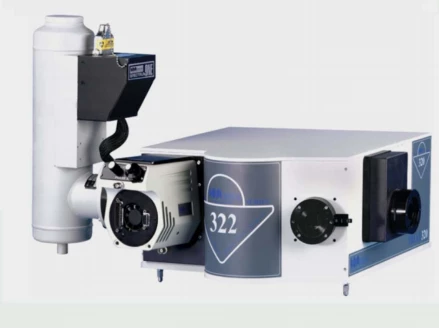TRIAX550 Imaging Spectrograph
Description
The TRIAX series use special corrective optics that maintain an excellent image quality and resolution along the length of the slit as well as along the dispersion axis in the exit focal plane. Thus, a point source on the entrance slit is re-imaged as a point for every occurrence of its wavelength in the focal plane. This makes TRIAX instruments the ideal spectrographs for a wide application range of high resolution multichannel spectroscopy.
TRIAX550 Imaging Spectrograph
Specifications |
|
|---|---|
| Monochromator Type: | Not Specified |
| Effective Focal Length: | 550 mm |
| Diffraction Grating: | 1200 lines/mm |
| Grating Blaze Wavelength: | -- nm |
| Spectral Range: | 185-15000nm |
| Linear Dispersion (Avg): | 1.55 nm/mm |
| Spectral Resolution (Avg): | 0.03 nm |
Features
Compact & Economical
Fully Automated
Excellent Image Quality
Large 30 mm x 12 mm Flat Image Field
High Thoughput
Rediffracted Light Eliminated
High Precision Automated Slits
Patented Triple Grating Turret
On-Axis Grating Rotation
Built-in Control of Optional Filter Wheel
Built-in RS232 & IEEE Interfaces
32 bit LabVIEW® Drivers Available
Optional Handheld Controller
Applications
For pricing, technical or any other questions please contact the supplier
- No registration required
- No markups, no fees
- Direct contact with supplier
-
Ships from:
United States
-
Sold by:
-
On FindLight:
since 2016
Frequently Asked Questions
The TRIAX series imaging spectrograph is used for a wide application range of high resolution multichannel spectroscopy, including spectrometry, spectroscopy, imaging, fluorescence, forensics, optical spectroscopy, Raman, emission, OEM and gratings, and thin film.
The features of the TRIAX series imaging spectrograph include compact and economical design, fully automated adjustments, excellent image quality, large 30 mm x 12 mm flat image field, high throughput, rediffracted light elimination, patented triple grating turret, on-axis grating rotation, built-in control of optional filter wheel, built-in RS232 and IEEE interfaces, and 32 bit LabVIEW® drivers available.
The TRIAX series imaging spectrograph uses special corrective optics that maintain an excellent image quality and resolution along the length of the slit as well as along the dispersion axis in the exit focal plane. Thus, a point source on the entrance slit is re-imaged as a point for every occurrence of its wavelength in the focal plane.
The TRIAX series imaging spectrograph has been optically optimized by using toroidal mirrors and an asymmetric optical path for superb exit imaging quality with the lowest re-entrant and stray light. TRIAXs are also equipped with larger focusing mirrors for a maximized non-vignetted and maximum optical throughput. Each spectrometer in the TRIAX series can be provided with up to three gratings mounted in a single turret.
Several options are available for the TRIAX series imaging spectrograph, including automated port selection on both entrance and exit, filter wheel drive capability, microstep motor, 2 or 7 mm maximum slit aperture, dual array capability, tiltable flange accommodating to most array detectors, and single channel detectors as PMT, solid state detectors.
